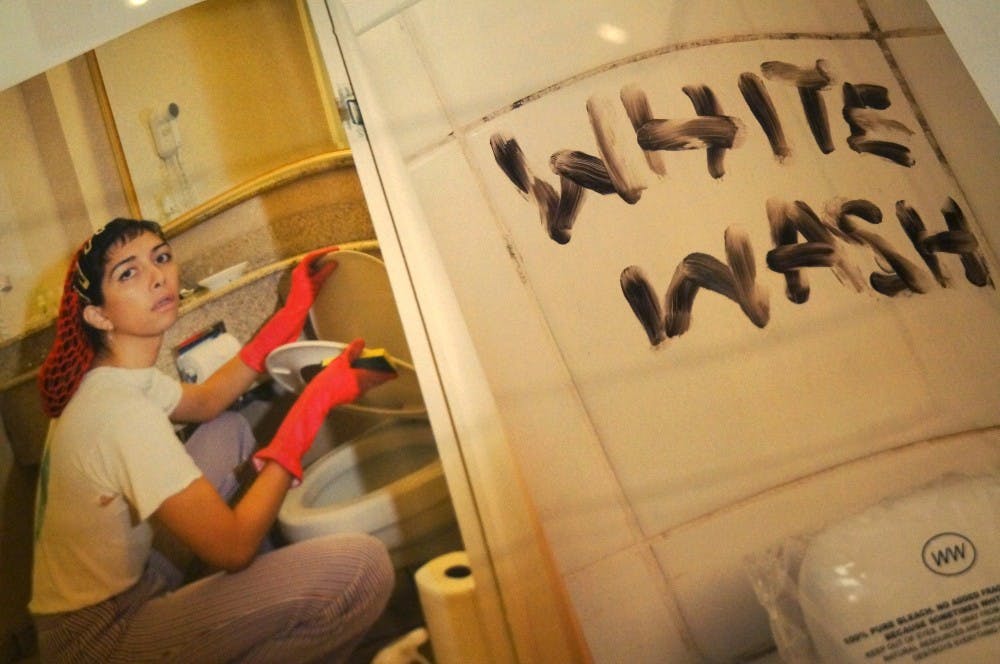With the Cville Pride Festival happening this past weekend, it’s important to take some time to reflect not only on the roots of LGBTQ activism but also its erasure from art history. This past June marked the 50th anniversary of the 1969 Stonewall Uprising. This movement, led by transgender women of color, was against discriminatory police raids on the Stonewall Inn and bar in New York City and was an important catalyst in the struggle for LGBTQ rights in the United States. “Otherwise,” a new exhibit at the Fralin Museum of Art, gives a perfect opportunity to think about where we have come from and where we might want to go.
Assistant Curator Hannah Cattarin said the exhibit that she spent the last year researching and compiling is not necessarily about Stonewall as much as it is dedicated to it.
“There is no universal queer aesthetic,” Cattarin said as she guided our group of around 30 “partygoers” through the exhibit’s three sections — “Self,” “Subject” and “Style.” “There is something here for everyone to find themselves in.”
Because there is no universal aesthetic form, there is no singular way to showcase the art or exact medium requirement. There’s no right way to enjoy it either. This may be why the museum party on a Wednesday night had tables dedicated to creating name tags with feathers, glitter glue and googly eyes. Cardi B’s unmistakable voice came drifting up the stairs from the speakers below, and the faint scent of charcuterie and cider followed.
Explicit queerness surrounded this event. “Otherwise” is not about hiding. As a member of the LGBTQ community herself, Cattarin wore a shirt that said “This is what a lesbian looks like.” The button making station downstairs allowed others to walk around with pins that say their preferred pronouns, “I am out therefore I am,” “The Stonewall Inn” and even buttons with activist Marsha P. Johnson’s face on them. The name of the game is showcasing the LGBTQ influence in art both in the place of creator and observer. Cattarin commented on the lack of discussion of queer artists in art history. The exhibit is as much about LGBTQ society as it is about identity culture and claiming space for yourself while still leaving space for others.
Part of making the Fralin a safe space for the community included looking into what queer art the museum already had in its permanent collection. Unlike many other institutions commemorating the Stonewall Uprising’s 50th anniversary, all of the works in “Otherwise” are from the permanent collection except for two new pieces. The downside of looking for artwork for and by queer artists who have previously not been recognized for their full identity? You are going to get a lot of art by cisgender white men.
“It’s a side effect of white supremacy,” Cattarin said. “We know that this is not what the LGBTQ+ community looks like.” This is why the “Self” and “Subject” sections of “Otherwise” are so important. “Self” gives a chance for artists to actually dissect identity politics — whether that is showing how race and sexuality interact in society or how gender binaries can be thwarted. “Subject” on the other hand seeks to showcase queer artists depicting the LGBTQ community and allies, rather than depending on someone else looking in.
“Straight artists often render queer subjects in a phobic way,” Cattarin said. “Subject” is a space to display the art that is not hypersexualized by a heteronormative eye.
As Cattarin guides our group around the sections, we stop at Martine Gutierrez’s corner. Gutierrez, a trans woman of color, has created an entire high-fashion style magazine of art dedicated to showcasing indigenous and queer identity. The piece, entitled “Indigenous Woman,” is so incredibly detailed that one might easily mistake it for a magazine with actual advertisements in it — the page open in the magazine could be mistaken as just a photograph of a working woman and an ad beside it, but when you read the fine print of “White Wash” the bleach block’s warning label reads: “100% Pure bleach. No added fragrance. No fuss. Because sometimes white is right. Keep out of eyes. Keep away from children, animals, natural resources and indigenous cultures. Destroys everything on contact.”
This piece is a crowd favorite and Cattarin notes that throughout the exhibit’s run in the Fralin — “Otherwise” will stay until Jan. 5, 2020 — they will turn the pages to reveal other, equally wonderful, witty and detailed frames by Gutierrez.
At the end of the night, I ended up staring at one photograph on the Subject wall — “Vivienne in the green dress,” photographed by Nan Goldin in a New York City apartment in 1980. It did not initially catch my eye — I was one of many fascinated by Gutierrez’s magazine, a plaster cast of Paul Thek’s head and some old Andy Warhol photographs. However, in this moment, I was enraptured by the tenderness of Goldin’s photos, the candid nature, the slight annoyance on Vivienne’s face at her photo being taken. While I was still furiously taking notes on all the information I had observed that night and looked down to get the date the photo was captured, I caught my own reflection in the emerald chiffon of Vivenne’s dress — and for whatever reason was shocked to see that I too can exist in this narrative of artists and history designed to make people feel like they belong. My reflection laughs in Vivenne’s skirt as I think back on Cattarin’s words.
“There is something here for everyone to find themselves in.”







